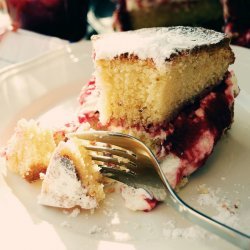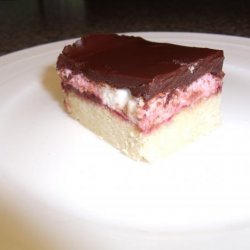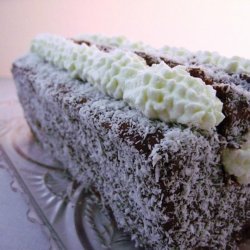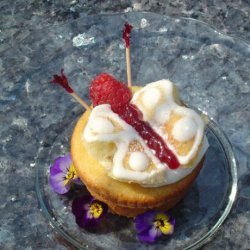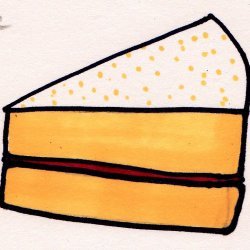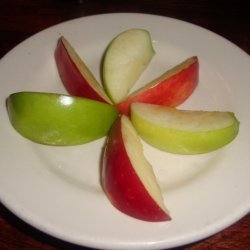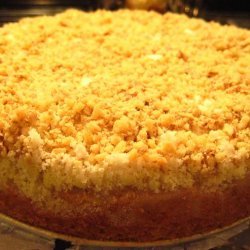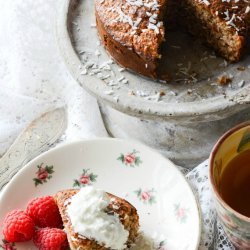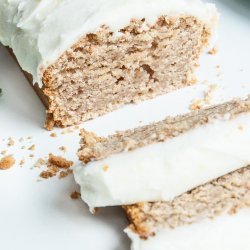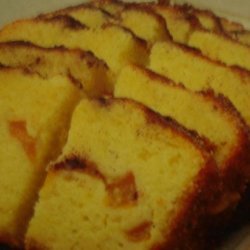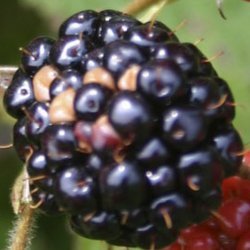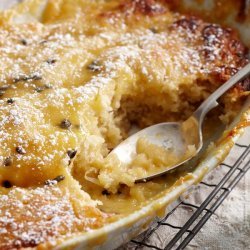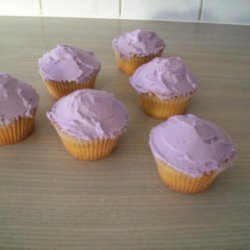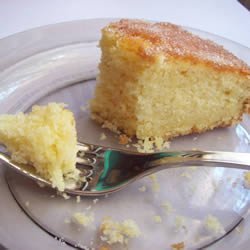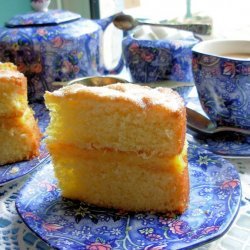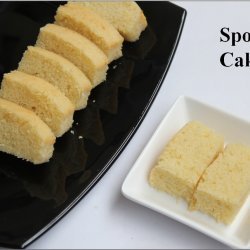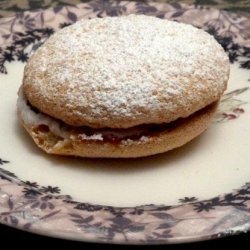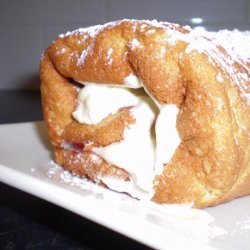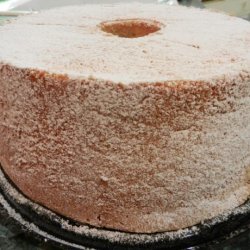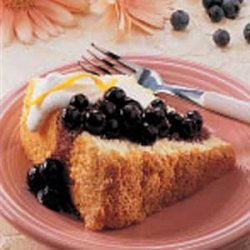Directions:
- Preheat the oven to gas mark 3, 325F (170C).
- In a medium-sized mixing bowl cream the butter and sugar together until you get a pale, fluffy mixture that drops off the spoon easily (an electric hand whisk speeds this up considerably, but a wooden spoon will do). Then in a separate jug or bowl, beat the eggs thoroughly together, then add them a little at a time, beating well after each addition. For a beginner, I would recommend just a teaspoonful of egg at a time: if you add it like this, it won't curdle. (Why shouldn't it curdle, you're thinking? Well, some of the hidden air that by now has been beaten into the mixture will escape if the mixture 'breaks' and as air is what makes a cake light, curdling will make it heavier.).
- When the eggs have been incorporated, take a metal tablespoon, which will cut and fold the flour in much better than a thick wooden spoon. Have the flour in a sieve resting on a plate, then lift the sieve high above the bowl and sift about a quarter of it on to the mixture - then replace the sieve on the plate and lightly and gently fold the flour into the mixture (if you beat the flour in, you'll lose some of the precious air). Then repeat this until all the flour is incorporated: lifting the sieve up high above the bowl will ensure the flour gets a good airing before it reaches the mixture.
- Now the flour has been added you should have a mixture that will drop off the spoon easily when you tap it on the side of the bowl. If not, add some hot water, one or two teaspoonfuls or if you're using medium eggs you may need a tablespoonful more. Now divide the mixture equally between the prepared tins - if you want to be very precise you could place both tins on the balance scales (I've never bothered because, quite honestly, I don't mind if one sponge is fractionally larger than the other.) Place them on the centre shelf of the oven, and they'll take about 25-30 minutes to cook.
- When they are cooked, the centres will feel springy when lightly touched with a little fingertip and no imprint remains. I think the secret of success here is to be patient and not to have crafty peeps halfway through: a sudden rush of cold coming into the oven can cause the cakes to sink. When they're cooked, remove them from then oven, then after about 1 minute turn them out on to a wire cooling tray, loosening them around the edges with a palette knife first. Then carefully peel off the base papers and leave the cakes to cool completely before sandwiching them together with jam and sifting a little icing sugar over the surface.
- Then fillings can vary from just jam or a mixture of jam and whipped cream, to lemon curd or chocolate fudge icing. Also you can flavour the cake mixture with grated lemon or orange rind or a few drops of vanilla extract. For a coffee flavour, dilute a tablespoon of instant coffee with a dessertspoon of hot water. For a chocolate flavour, take out a level tablespoon of flour and replace it with a level tablespoon of cocoa.
- In a medium-sized mixing bowl cream the butter and sugar together until you get a pale, fluffy mixture that drops off the spoon easily (an electric hand whisk speeds this up considerably, but a wooden spoon will do). Then in a separate jug or bowl, beat the eggs thoroughly together, then add them a little at a time, beating well after each addition. For a beginner, I would recommend just a teaspoonful of egg at a time: if you add it like this, it won't curdle. (Why shouldn't it curdle, you're thinking? Well, some of the hidden air that by now has been beaten into the mixture will escape if the mixture 'breaks' and as air is what makes a cake light, curdling will make it heavier.).
- When the eggs have been incorporated, take a metal tablespoon, which will cut and fold the flour in much better than a thick wooden spoon. Have the flour in a sieve resting on a plate, then lift the sieve high above the bowl and sift about a quarter of it on to the mixture - then replace the sieve on the plate and lightly and gently fold the flour into the mixture (if you beat the flour in, you'll lose some of the precious air). Then repeat this until all the flour is incorporated: lifting the sieve up high above the bowl will ensure the flour gets a good airing before it reaches the mixture.
- Now the flour has been added you should have a mixture that will drop off the spoon easily when you tap it on the side of the bowl. If not, add some hot water, one or two teaspoonfuls or if you're using medium eggs you may need a tablespoonful more. Now divide the mixture equally between the prepared tins - if you want to be very precise you could place both tins on the balance scales (I've never bothered because, quite honestly, I don't mind if one sponge is fractionally larger than the other.) Place them on the centre shelf of the oven, and they'll take about 25-30 minutes to cook.
- When they are cooked, the centres will feel springy when lightly touched with a little fingertip and no imprint remains. I think the secret of success here is to be patient and not to have crafty peeps halfway through: a sudden rush of cold coming into the oven can cause the cakes to sink. When they're cooked, remove them from then oven, then after about 1 minute turn them out on to a wire cooling tray, loosening them around the edges with a palette knife first. Then carefully peel off the base papers and leave the cakes to cool completely before sandwiching them together with jam and sifting a little icing sugar over the surface.
- Then fillings can vary from just jam or a mixture of jam and whipped cream, to lemon curd or chocolate fudge icing. Also you can flavour the cake mixture with grated lemon or orange rind or a few drops of vanilla extract. For a coffee flavour, dilute a tablespoon of instant coffee with a dessertspoon of hot water. For a chocolate flavour, take out a level tablespoon of flour and replace it with a level tablespoon of cocoa.
- Note: For an 8 inch (20 cm) sponge cake, use 6 oz (175g) of each ingredient and 3 eggs.
Nutrition Facts
| Amount Per 1 Serving | |||
| Calories | 245.67 Kcal (1029 kJ) | ||
| Calories from fat | 115.86 Kcal | ||
| % Daily Value* | |||
| Total Fat | 12.87g | 20% | |
|---|---|---|---|
| Cholesterol | 76.98mg | 26% | |
| Sodium | 79.98mg | 3% | |
| Potassium | 20.65mg | 0% | |
| Total Carbs | 30.88g | 10% | |
| Sugars | 14.18g | 57% | |
| Dietary Fiber | 0.28g | 1% | |
| Protein | 2.05g | 4% | |
| Vitamin A | 0.1mg | 5% | |
| Iron | 0.3mg | 1% | |
| Calcium | 15.2mg | 2% | |
| Amount Per 100 g | |||
| Calories | 446.46 Kcal (1869 kJ) | ||
| Calories from fat | 210.56 Kcal | ||
| % Daily Value* | |||
| Total Fat | 23.4g | 20% | |
|---|---|---|---|
| Cholesterol | 139.89mg | 26% | |
| Sodium | 145.35mg | 3% | |
| Potassium | 37.53mg | 0% | |
| Total Carbs | 56.13g | 10% | |
| Sugars | 25.76g | 57% | |
| Dietary Fiber | 0.52g | 1% | |
| Protein | 3.73g | 4% | |
| Vitamin A | 0.3mg | 5% | |
| Iron | 0.5mg | 1% | |
| Calcium | 27.7mg | 2% | |
* Percent Daily Values are based on a 2000 calorie diet. Your daily values may be higher or lower depending on your calorie needs.
Find out how many calories should you eat.
Get Your Recipe of Health!
Follow RecipeOfHealth on Facebook!


